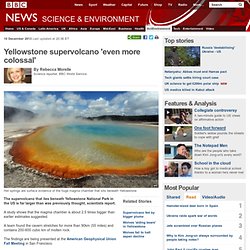

Yellowstone Earthquake Threat High In 2014, Says USGS; What Does This Mean For A Volcano Eruption? The threat of the Yellowstone volcano blowing its top has some people fearing the possibility since a supervolcano eruption has the power of a nuclear explosion.

But if the United States Geological Survey (USGS) now says the Yellowstone earthquake threat is high, then is there any reason to worry in the coming years? In a related report by The Inquisitr, a Mount Fuji eruption is feared since it’s said the famous Japanese mountain is in a “critical state.” Yellowstone conspiracy theory supporters claim USGS is hiding earthquake data in order to prevent national panic, and when it was claimed the National Guard was preparing for an “event” at Yellowstone National Park, the conspiracy theorist websites took that information and ran with it.
To a certain extent, these fears are justified. For example, the British Geological Survey claims the threat of a supervolcano is more likely than the dangers posed by global warming or World War 3. Yellowstone supervolcano 'even more colossal' 10 December 2013Last updated at 20:36 ET By Rebecca Morelle Science reporter, BBC World Service Hot springs are surface evidence of the huge magma chamber that sits beneath Yellowstone The supervolcano that lies beneath Yellowstone National Park in the US is far larger than was previously thought, scientists report.

A study shows that the magma chamber is about 2.5 times bigger than earlier estimates suggested. A team found the cavern stretches for more than 90km (55 miles) and contains 200-600 cubic km of molten rock. The findings are being presented at the American Geophysical Union Fall Meeting in San Francisco. Prof Bob Smith, from the University of Utah, said: “We’ve been working there for a long time, and we’ve always thought it would be bigger... but this finding is astounding. " Earth Science. Mount Pinatubo Eruption - Eruption of Mount Pinatubo.
Updated November 11, 2010 In June 1991, the second largest volcanic eruption of the twentieth century* took place on the island of Luzon in the Philippines, a mere 90 kilometers (55 miles) northwest of the capital city Manila.

Up to 800 people were killed and 100,000 became homeless following the Mount Pinatubo eruption, which climaxed with nine hours of eruption on June 15, 1991. On June 15, millions of tons of sulfur dioxide were discharged into the atmosphere, resulting in a decrease in the temperature worldwide over the next few years. Mount Pinatubo is part of a chain of composite volcanoes along the Luzon arc on the west coast of the island (area map). The arc of volcanoes is due to the subduction of the Manila trench to the west. The events of the 1991 Mount Pinatubo eruption began in July 1990, when a magnitude 7.8 earthquake occurred 100 kilometers (62 miles) northeast of the Pinatubo region, determined to be a result of the reawakening of Mount Pinatubo. Pinatubo. Ethiopia's blue volcano burns deadly sulphuric gas - environment - 27 May 2014.
(Image: Olivier Grunewald) IT'S a volcano, but not as we know it.

This cerulean eruption takes place in the Danakil Depression, a low-lying plain in Ethiopia. The volcano's lava is the usual orange-red – the blue comes from flames produced when escaping sulphuric gases burn. French photographer Olivier Grunewald creates such images without using colour filters or digital enhancement, which is no simple task. To get this shot he had to wait until dusk, when the electric blue flames were visible, but before all the daylight had ebbed away. Grunewald works in a gas mask to avoid breathing in the deadly fumes – but photographing Kawah Ijen still left him with peeling skin and clothes smelling of rotten eggs for weeks afterwards. Another drawback of Grunewald's subject matter is that the acidic gases don't agree with his cameras. This article appeared in print under the headline "Volcano in blue" More From New Scientist Deepest point in the ocean is teeming with life (New Scientist)
Sangeang Api latest - VOLCANO PLANET.